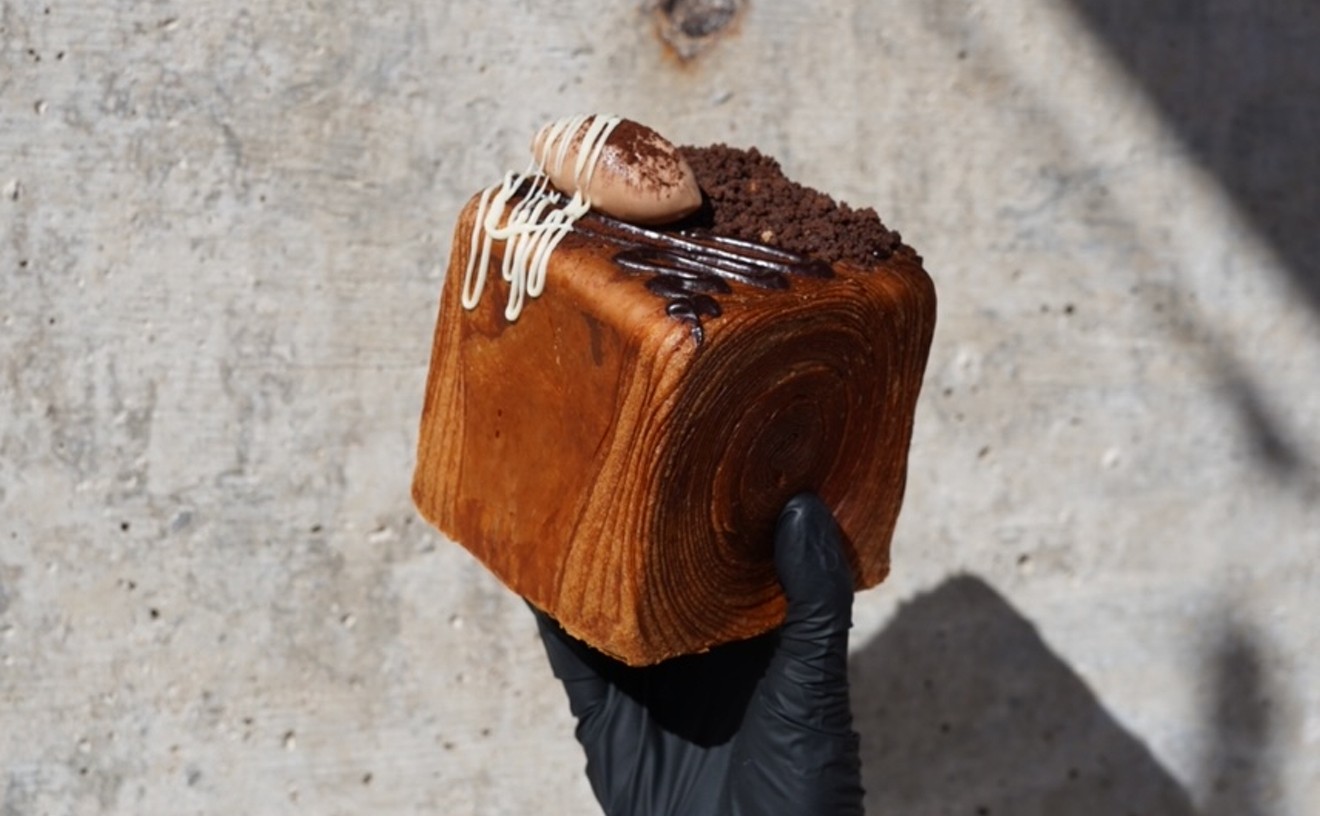Colorado barbecue: two words that many smoked-meat enthusiasts think just don’t go together. This state lacks the tradition, they explain, arguing that all of the barbecue in Colorado is inspired by barbecue from somewhere else. There’s some truth to that: In Denver and the surrounding suburbs, we can find Texas brisket, Carolina pulled pork, Kansas City burnt ends and Memphis or Saint Louis ribs — sometimes all at the same restaurant (much to the frustration of purists). But barbecue itself is as old as the hills (whether the Appalachians or the Hill Country of central Texas) and the necessities are bare-bones: just hardwood and meat. Surely early settlers here were cooking cheap cuts of cow and other critters over low heat for long periods of time. So where did those ’cue traditions go?
Plenty of Coloradans fire up their smokers every weekend, enough to fill the membership rolls of organizations like the Rocky Mountain BBQ Association with hundreds of amateur pit masters, many of whom compete in local and national cook-offs. Given that, you might imagine that the RMBBQA would advocate for barbecue specific to Colorado and the surrounding mountain states, but that’s not the case.
“Rocky Mountain BBQ is a competition group that cooks by Kansas City BBQ rules,” explains RMBBQA president Bob Oldfield. “Therefore, we only cook chicken, pork ribs, pork shoulder and brisket. These are the four meats used in competition, and other than home use, we aren’t allowed to deviate from that.”
So that rules out lamb, bison, elk and venison, four regional meats that early Coloradans relied on as a source of protein. As for indigenous hardwoods, “Everything we use is imported from Southern states, as Colorado is primarily a pine and aspen state,” says Oldfield.
He’s right: Pine and aspen can be burned as fuel, and while the coals can be used for campfire cooking, soft woods like these burn too quickly and emit flavors that would ruin meats coming into contact with the smoke. Still, there’s plenty of evidence that cooks in the 1800s were barbecuing here. Adrian Miller, accredited barbecue judge and James Beard Award-winning author of Soul Food: The Surprising Story of an American Cuisine, One Plate at a Time, says that lamb was a popular choice, especially in the pre-statehood decades when the cattle industry hadn’t yet become a major agricultural force in the area. From the photographs he’s studied, Miller has determined that both Texas pit-style barbecue and Deep South style, where cooks dug six-foot trenches and slow-roasted whole butterflied animals, were common.
“These barbecues in the past were gargantuan,” he notes, feeding gatherings of 5,000 people — and sometimes as many as 35,000. Accompaniments were rudimentary, with just bread, coffee and sometimes potatoes; more common sides like beans, potato salad and coleslaw arrived later.
But economics and ranching trends forced beef to the forefront, and lamb barbecue faded from Colorado cooking. Miller says that in the early to mid-1900s, you could ask for Denver ribs at the butcher shop and the meat cutter would know you wanted lamb, but at Oliver’s Meat Market on East Sixth Avenue, a family-owned butcher shop open since 1923, the owner says that orders for lamb ribs are very uncommon these days, even though the shop sells plenty of other lamb cuts.
What does this mean for professional pit masters looking for clues about Colorado’s meat-smoking history? “Because there has been such a break with tradition, people are having to learn through trial and error,” Miller explains.
But now a small group of chefs are attempting to put the Colorado back into Colorado barbecue in various ways. One of the first to specifically use the phrase “Colorado barbecue” and offer smoked lamb and bison was Coy Webb, who opened Roaming Buffalo in early 2015 with his wife, Rachael. Webb grew up in Texas, attended culinary school and has worked as a chef for his entire career, but he’s been barbecuing since he was a kid and developed his style with his dad while cooking over pecan wood harvested from his family’s property. Once in Colorado, he became interested in regional meats — and when Roaming Buffalo debuted, lamb shoulder and shank as well as bison short ribs were part of the program. Webb has since tightened the menu to bison back ribs and lamb shoulder, which he has Superior Farms cut to his specifications. And if you arrive early enough, you might score some housemade venison sausage, which tends to sell out quickly each day.
Webb’s reasons for exploring Colorado traditions are both community- and business-oriented. “I found it interesting that nobody was doing what was originally here,” he explains. “And I thought, ‘I can help do my part to bring it back.’ I also want to be original, and I want Colorado to have its roots and to help rebuild those roots.
“Lamb was done out of necessity,” he adds. “It was chuckwagon cooking.” But once heartier breeds of cattle were introduced to the region, lamb slowly lost favor because cattle were more profitable to raise than sheep, he notes. Webb uses a blend of pecan, white oak and red oak pellets for his woods, pointing out that pellets are much more efficient and eco-friendly than whole wood.
Over at Owlbear Barbecue, which serves mainly Texas-style meats inside the food-truck corral at Finn’s Manor, owner Karl Fallenius prefers using whole wood to fuel his offset smoker. He has researched indigenous woods and tries to use them when he can, but supplies can be difficult to come by. “When we first started, we were using all Gambel oak, which grows throughout western and southern Colorado,” Fallenius says. “But it’s hard to find.”
Other Colorado woods, including native species of ash, can be used — but they’re rare on the market and tricky to use. Western Daughters Butcher Shoppe, where Fallenius gets his Boulder Farms chicken, uses cottonwood for its house-smoked meats, he points out.
From his research into Colorado’s barbecue history, Fallenius learned that harsh conditions and high altitude limited what earlier settlers could do outdoors. “It was always a little more survival-oriented,” he notes. But that hasn’t slowed him down. Cold-weather barbecuing is definitely a challenge, since more wood and longer cooking times are required (another reason that barbecue has achieved ascendancy mostly in warmer climates). On winter days, Fallenius can be found warming himself in front of his smoker as his meats slowly cook.
Brand-new to the scene is Sloan’s Lake Tap & Burger, where chef Elijah Odell has added a whole section titled “Colorado Barbecue” to the menu. He began smoking meats at the original Highland Tap & Burger, using oak whiskey-barrel staves from Denver distilleries to add flavor and local flair to his chicken wings. A new restaurant with a much larger kitchen gave him room to expand and experiment — and he wanted to make his barbecue distinct, rather than borrowing traditions from other regions. “Because of the fact that barbecue is so regional, I didn’t want to fight with anyone or argue with anyone about what barbecue means,” Odell explains. “The fact that I live in Colorado, I want it to be as fresh as possible and as local as possible.”
So while the oak didn’t grow in Colorado, the barrels have spent their entire useful lives holding Colorado products. Odell was originally obtaining barrels directly from Laws Whiskey House, but craft breweries started buying them up, driving the price too high for the restaurant. Now he gets his wood from brewers, who use the barrels for aging sour beers until they’re falling apart. Although he loses the whiskey element that added distinctive flavor to the finished barbecue, the cost is far less.
Odell’s barbecue menu includes bison brisket (“We liked the challenge of it”), lamb leg and shoulder, pulled pork, and housemade pork sausage flavored with green chiles, Dale’s Pale Ale and white cheddar. His pork shoulder is brined in local brown ale, and the dry rub (created by chef de cuisine Toby Prout) includes guajillo and ancho chiles toasted and ground in-house for a touch of Southwestern flavor.
Colorado lacks many of the requisite elements for a thriving barbecue scene: abundant hardwood, year-round weather suitable for cooking outdoors, the kinds of historical gatherings and continuous farming traditions that spawned regional barbecue (like whole-hog cooking in South Carolina or mutton barbecue in Owensboro, Kentucky). And ours is primarily an immigrant population, where folks from all over America have arrived, bringing their own traditions with them.
The lack of a clear history and tradition is a blessing in disguise, though, for cooks looking to forge a new path. Fallenius puts it well: “We really have an opportunity to explore what barbecue can become instead of what it already is.”
[
{
"name": "Air - MediumRectangle - Inline Content - Mobile Display Size",
"component": "12017618",
"insertPoint": "2",
"requiredCountToDisplay": "2"
},{
"name": "Editor Picks",
"component": "17242653",
"insertPoint": "4",
"requiredCountToDisplay": "1"
},{
"name": "Inline Links",
"component": "18838239",
"insertPoint": "8th",
"startingPoint": 8,
"requiredCountToDisplay": "7",
"maxInsertions": 25
},{
"name": "Air - MediumRectangle - Combo - Inline Content",
"component": "17261320",
"insertPoint": "8th",
"startingPoint": 8,
"requiredCountToDisplay": "7",
"maxInsertions": 25
},{
"name": "Inline Links",
"component": "18838239",
"insertPoint": "8th",
"startingPoint": 12,
"requiredCountToDisplay": "11",
"maxInsertions": 25
},{
"name": "Air - Leaderboard Tower - Combo - Inline Content",
"component": "17261321",
"insertPoint": "8th",
"startingPoint": 12,
"requiredCountToDisplay": "11",
"maxInsertions": 25
}
]











